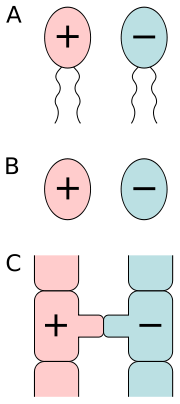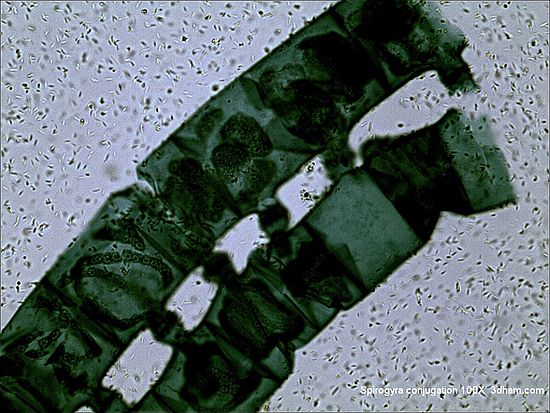
Isogamy
Encyclopedia

Sexual reproduction
Sexual reproduction is the creation of a new organism by combining the genetic material of two organisms. There are two main processes during sexual reproduction; they are: meiosis, involving the halving of the number of chromosomes; and fertilization, involving the fusion of two gametes and the...
that involves gamete
Gamete
A gamete is a cell that fuses with another cell during fertilization in organisms that reproduce sexually...
s of similar morphology
Morphology (biology)
In biology, morphology is a branch of bioscience dealing with the study of the form and structure of organisms and their specific structural features....
(similar shape and size), differing only in allele
Allele
An allele is one of two or more forms of a gene or a genetic locus . "Allel" is an abbreviation of allelomorph. Sometimes, different alleles can result in different observable phenotypic traits, such as different pigmentation...
expression
Gene expression
Gene expression is the process by which information from a gene is used in the synthesis of a functional gene product. These products are often proteins, but in non-protein coding genes such as ribosomal RNA , transfer RNA or small nuclear RNA genes, the product is a functional RNA...
in one or more mating-type region
Mating-type region
The mating-type region is a specialized region in the genomes of some yeast and other fungi, usually organized into heterochromatin and possessing unique histone methylation patterns. The genes in this region regulate the mating type of the organism and therefore determine key events in its life...
s. Because both gametes look alike, they cannot be classified as "male
Male
Male refers to the biological sex of an organism, or part of an organism, which produces small mobile gametes, called spermatozoa. Each spermatozoon can fuse with a larger female gamete or ovum, in the process of fertilization...
" or "female
Female
Female is the sex of an organism, or a part of an organism, which produces non-mobile ova .- Defining characteristics :The ova are defined as the larger gametes in a heterogamous reproduction system, while the smaller, usually motile gamete, the spermatozoon, is produced by the male...
." Instead, organisms undergoing isogamy are said to have different mating type
Mating type
Mating types occur in eukaryotes that undergo sexual reproduction via isogamy. Since the gametes of different mating types look alike, they are often referred to by numbers, letters, or simply "+" and "-" instead of "male" and "female." Mating can only take place between different mating...
s, most commonly noted as "+" and "-" strains, although in some species there are more than two mating types (designated by numbers or letters). Fertilization occurs when gametes of two different mating types fuse to form a zygote
Zygote
A zygote , or zygocyte, is the initial cell formed when two gamete cells are joined by means of sexual reproduction. In multicellular organisms, it is the earliest developmental stage of the embryo...
.
Evolution
It appears that isogamy was the first stage of sexual reproductionSexual reproduction
Sexual reproduction is the creation of a new organism by combining the genetic material of two organisms. There are two main processes during sexual reproduction; they are: meiosis, involving the halving of the number of chromosomes; and fertilization, involving the fusion of two gametes and the...
. In several lineages (plants, animals), this form of reproduction independently evolved to anisogamous
Anisogamy
Anisogamy refers to a form of sexual reproduction involving the union or fusion of two dissimilar gametes — anisogamous, anisogamic,...
species with gamete
Gamete
A gamete is a cell that fuses with another cell during fertilization in organisms that reproduce sexually...
s of male and female
Female
Female is the sex of an organism, or a part of an organism, which produces non-mobile ova .- Defining characteristics :The ova are defined as the larger gametes in a heterogamous reproduction system, while the smaller, usually motile gamete, the spermatozoon, is produced by the male...
types to oogamous
Oogamy
Oogamy is the familiar form of sexual reproduction. It is a form of anisogamy in which the female gamete is significantly larger than the male gamete and is non-motile. The male gametes are typically highly motile spermatozoa competing for the fertilization of the immotile egg.By contrast to...
species in which the female gamete is very much larger than the male and has no ability to move. There is a good argument that this pattern was driven by the physical constraints on the mechanisms by which two gametes get together as required for sexual reproduction
Sexual reproduction
Sexual reproduction is the creation of a new organism by combining the genetic material of two organisms. There are two main processes during sexual reproduction; they are: meiosis, involving the halving of the number of chromosomes; and fertilization, involving the fusion of two gametes and the...
.
Biological types
There are several types of isogamy. Both gametes may be flagellatedFlagellum
A flagellum is a tail-like projection that protrudes from the cell body of certain prokaryotic and eukaryotic cells, and plays the dual role of locomotion and sense organ, being sensitive to chemicals and temperatures outside the cell. There are some notable differences between prokaryotic and...
and thus motile. This type occurs for example in algae
Algae
Algae are a large and diverse group of simple, typically autotrophic organisms, ranging from unicellular to multicellular forms, such as the giant kelps that grow to 65 meters in length. They are photosynthetic like plants, and "simple" because their tissues are not organized into the many...
such as Chlamydomonas
Chlamydomonas
Chlamydomonas is a genus of green algae. They are unicellular flagellates. Chlamydomonas is used as a model organism for molecular biology, especially studies of flagellar motility and chloroplast dynamics, biogenesis, and genetics...
and other plants.
In another type, neither of the gametes is flagellated. This is the case for example in the mating of yeast
Mating of yeast
The yeast Saccharomyces cerevisiae is a simple single celled eukaryote with both a diploid and haploid mode of existence. The mating of yeast only occurs between haploids, which can be either the a or α mating type and thus display simple sexual differentiation...
. Yeast mating types are commonly noted as "a" and "α" (alpha) instead of "+" and "-".
Another, more complex form, is conjugation. This occurs in some green algae, for example in Spirogyra
Spirogyra
Spirogyra is a genus of filamentous green algae of the order Zygnematales, named for the helical or spiral arrangement of the chloroplasts that is diagnostic of the genus. It is commonly found in freshwater areas, and there are more than 400 species of Spirogyra in the world. Spirogyra measures...
. These algae grow as filaments of cells. When two filaments of opposing mating types come close together, the cells form conjugation tubes between the filaments. Once the tubes are formed, one cell balls up and crawls through the tube into the other cell to fuse with it, forming a zygote.
Fungi
Fungus
A fungus is a member of a large group of eukaryotic organisms that includes microorganisms such as yeasts and molds , as well as the more familiar mushrooms. These organisms are classified as a kingdom, Fungi, which is separate from plants, animals, and bacteria...
also use conjugation. In zygomycetes, two hyphae of opposing mating types form special structures called gametangia
Gametangia
A gametangium is an organ or cell in which gametes are produced that is found in many multicellular protists, algae, fungi, and the gametophytes of plants...
where the hyphae touch. The gametangia then fuse into a zygosporangium
Zygospore
A zygospore is a diploid reproductive stage in the life cycle of many fungi and protists. Zygospores are created by the nuclear fusion of haploid cells. In fungi, zygospores are termed chlamydospores and are formed after the fusion of hyphae of different mating types...
. In other fungi, cells from two hyphae with opposing mating types fuse, but only cytoplasmic (plasmogamy
Plasmogamy
Plasmogamy is a stage in the sexual reproduction of fungi. In this stage, the cytoplasm of two parent mycelia fuse together without the fusion of nuclei, as occurs in higher terrestrial fungi. After plasmogamy occurs, the secondary mycelium forms. The secondary mycelium consists of dikaryotic...
). The two nuclei do not fuse, leading to the formation of a dikaryon
Dikaryon
Dikaryon is from Greek, di meaning 2 and karyon meaning nut, referring to the cell nucleus.The dikaryon is a nuclear feature which is unique to some fungi, in which after plasmogamy the two compatible nuclei of two cells pair off and cohabit without karyogamy within the cells of the hyphae,...
cell that gives rise to a mycelium
Mycelium
thumb|right|Fungal myceliaMycelium is the vegetative part of a fungus, consisting of a mass of branching, thread-like hyphae. The mass of hyphae is sometimes called shiro, especially within the fairy ring fungi. Fungal colonies composed of mycelia are found in soil and on or within many other...
consisting of dikaryons. Karyogamy
Karyogamy
Karyogamy is the fusion of pronuclei of two cells, as part of syngamy, fertilization, or true bacterial conjugation.It is one of the two major modes of reproduction in fungi...
(fusion of nuclei) occurs in sporangia and leads to the formation of diploid cells (zygotes) that immediately undergo meiosis
Meiosis
Meiosis is a special type of cell division necessary for sexual reproduction. The cells produced by meiosis are gametes or spores. The animals' gametes are called sperm and egg cells....
to form spore
Spore
In biology, a spore is a reproductive structure that is adapted for dispersal and surviving for extended periods of time in unfavorable conditions. Spores form part of the life cycles of many bacteria, plants, algae, fungi and some protozoa. According to scientist Dr...
s.

Budding
Budding is a form of asexual reproduction in which a new organism grows on another one. The new organism remains attached as it grows, separating from the parent organism only when it is mature. Since the reproduction is asexual, the newly created organism is a clone and is genetically identical...
, or asexual spore formation. The switch to sexual reproduction
Sexual reproduction
Sexual reproduction is the creation of a new organism by combining the genetic material of two organisms. There are two main processes during sexual reproduction; they are: meiosis, involving the halving of the number of chromosomes; and fertilization, involving the fusion of two gametes and the...
mode is often triggered by a change from favorable to unfavorable growing conditions. Fertilization often leads to the formation of a thick-walled zygotic resting spore
Resting spore
A resting spore is a spore created by fungi which is thickly encysted in order to survive through stressful times, such as drought. It protects the spore from biotic , as well as abiotic factors.-Characteristics:Resting spores create the phenomenon known as late potato blight...
that can withstand harsh environments and will germinate once growing conditions turn favorable again.
Isogamy in social anthropology
The term isogamy is also used in anthropology to refer to marriageMarriage
Marriage is a social union or legal contract between people that creates kinship. It is an institution in which interpersonal relationships, usually intimate and sexual, are acknowledged in a variety of ways, depending on the culture or subculture in which it is found...
between people of equal social status
Social status
In sociology or anthropology, social status is the honor or prestige attached to one's position in society . It may also refer to a rank or position that one holds in a group, for example son or daughter, playmate, pupil, etc....
or caste
Caste
Caste is an elaborate and complex social system that combines elements of endogamy, occupation, culture, social class, tribal affiliation and political power. It should not be confused with race or social class, e.g. members of different castes in one society may belong to the same race, as in India...
.

